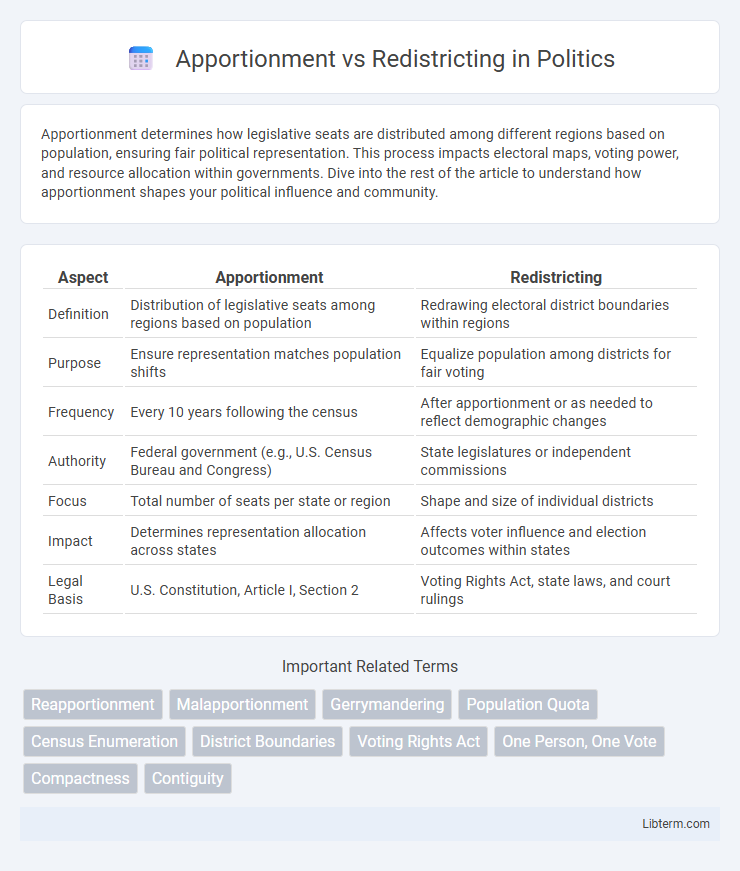Apportionment determines how legislative seats are distributed among different regions based on population, ensuring fair political representation. This process impacts electoral maps, voting power, and resource allocation within governments. Dive into the rest of the article to understand how apportionment shapes your political influence and community.
Table of Comparison
| Aspect | Apportionment | Redistricting |
|---|---|---|
| Definition | Distribution of legislative seats among regions based on population | Redrawing electoral district boundaries within regions |
| Purpose | Ensure representation matches population shifts | Equalize population among districts for fair voting |
| Frequency | Every 10 years following the census | After apportionment or as needed to reflect demographic changes |
| Authority | Federal government (e.g., U.S. Census Bureau and Congress) | State legislatures or independent commissions |
| Focus | Total number of seats per state or region | Shape and size of individual districts |
| Impact | Determines representation allocation across states | Affects voter influence and election outcomes within states |
| Legal Basis | U.S. Constitution, Article I, Section 2 | Voting Rights Act, state laws, and court rulings |
Introduction to Apportionment and Redistricting
Apportionment determines the allocation of legislative seats based on population data, primarily from the decennial census, ensuring proportional representation among states or districts. Redistricting involves the redrawing of electoral district boundaries within states to reflect population shifts and maintain equal representation. Both processes are crucial for upholding the principle of "one person, one vote" in democratic systems.
Definition and Purpose of Apportionment
Apportionment refers to the process of distributing legislative seats among different regions or states based on population data, ensuring proportional representation. Its primary purpose is to allocate seats fairly according to population changes identified through the census, maintaining equal representation in legislative bodies. Unlike redistricting, which redraws district boundaries within states, apportionment determines the number of seats each state receives in a legislative assembly.
Definition and Significance of Redistricting
Redistricting is the process of redrawing the boundaries of electoral districts to reflect population changes detected in the decennial census, ensuring equal representation under the principle of "one person, one vote." Unlike apportionment, which allocates the number of legislative seats per state based on population, redistricting determines the specific geographic boundaries within states where those representatives will be elected. The significance of redistricting lies in its impact on political power distribution, voter representation, and the fairness of electoral outcomes.
Key Differences Between Apportionment and Redistricting
Apportionment determines the allocation of legislative seats to states based on population data from the census, influencing the number of representatives each state receives. Redistricting involves redrawing electoral district boundaries within states to ensure equal population distribution among districts, maintaining fair voter representation. While apportionment manages seat distribution at the state level, redistricting addresses the geographic division of voters within states.
Legal Framework Governing Apportionment
The legal framework governing apportionment is primarily defined by the U.S. Constitution, specifically Article I, Section 2, and reinforced by the Fourteenth Amendment, which mandates equal population distribution among districts. Key legislative acts such as the Reapportionment Act of 1929 established the permanent method for apportioning seats in the House of Representatives based on decennial census data. Judicial decisions, including Baker v. Carr and Wesberry v. Sanders, have further shaped apportionment by enforcing the "one person, one vote" principle, ensuring equitable representation.
Legal Standards Influencing Redistricting
Legal standards influencing redistricting include the Voting Rights Act, which prohibits racial discrimination in electoral processes, and the Equal Protection Clause of the 14th Amendment, mandating districts with roughly equal populations. Court rulings such as Baker v. Carr established judicial review over redistricting to prevent malapportionment, while Shaw v. Reno addressed racial gerrymandering concerns. These standards ensure that redistricting promotes fair representation and complies with constitutional and statutory requirements.
Impact on Political Representation
Apportionment allocates congressional seats to states based on population changes from the decennial census, directly influencing the balance of political power in the House of Representatives. Redistricting redraws electoral district boundaries within states to reflect population shifts, shaping voter composition and potentially affecting party control at both state and federal levels. Both processes critically determine political representation, with apportionment setting the framework of power and redistricting refining the distribution of electoral influence.
Common Challenges in Apportionment and Redistricting
Common challenges in apportionment and redistricting include population shifts that necessitate accurate data analysis and timely adjustments to legislative boundaries. Ensuring fairness while avoiding gerrymandering remains a critical issue, as manipulation of district lines can undermine representative democracy. Compliance with legal standards such as the Voting Rights Act further complicates the process, requiring careful demographic consideration and judicial oversight.
Historical Examples and Case Studies
Apportionment determines the distribution of congressional seats based on population data from the census, exemplified by the 1920 census refusal to reapportion due to urban-rural population shifts causing political tensions. Redistricting involves redrawing electoral district boundaries within states, highlighted by the controversial 2010 Pennsylvania redistricting case, where gerrymandering was challenged for diluting minority voting power. Both processes significantly impact political representation, as demonstrated in landmark cases like Baker v. Carr (1962) mandating judicial oversight of redistricting for equal representation.
Future Trends in Apportionment and Redistricting
Future trends in apportionment will increasingly rely on advanced data analytics and real-time demographic tracking to ensure more precise representation based on population shifts. Redistricting is likely to incorporate AI-driven tools to create fairer, more competitive districts while reducing partisan gerrymandering. Emerging legal frameworks and technology-driven transparency measures will promote accountability and equity in both apportionment and redistricting processes.
Apportionment Infographic

 libterm.com
libterm.com